I. Outlook
1. Macroeconomic Summary and Future Predictions
Last week, the annualized GDP growth rate for the second quarter in the U.S. was revised up to 3.3%, indicating a rebound in the economy driven by consumer spending and AI investments. Meanwhile, the expansion of tariffs and increased imports have raised inflation and cost pressures. The market expects the probability of a Federal Reserve rate cut in September to rise rapidly to 85%, betting on a cumulative rate cut of up to 100 basis points within the year.
U.S. stocks experienced volatility last week, initially supported by strong GDP data and a surge in tech investments, with the Dow Jones and S&P 500 reaching historic highs. However, as signals of weak employment and declining confidence emerged, market sentiment became cautious, leading to pullbacks on some trading days. Overall, U.S. stocks reflect a coexistence of concerns over short-term economic pressures and optimism about medium- to long-term growth momentum.
2. Market Changes and Warnings in the Crypto Industry
Last week, after Powell released dovish signals at the Jackson Hole meeting, the crypto market briefly surged. Bitcoin quickly broke above $117,000, and Ethereum also rose close to $4,800, with the market generally expecting a rate cut from the Federal Reserve in September, driving short-term inflows into crypto assets. Overall sentiment warmed, leading to a temporary increase in mainstream coin prices.
However, selling pressure soon emerged, with large Bitcoin sell-offs triggering a chain reaction, causing Bitcoin to fall back to around $110,000, with Ethereum, XRP, and others also declining. Analysts warn that while easing expectations provide support, the crypto market still faces the risk of a pullback in the short term, and investors should pay attention to Bitcoin's key support levels and liquidity changes.
3. Industry and Sector Hotspots
STAN, an immersive esports fan interaction and digital collectibles experience platform backed by Google, gaming giants Bandai Namco and Square Enix, is designed specifically for esports enthusiasts; Kuvi.ai, a crypto interaction platform driven by AI that raised $700,000, aims to usher in a new era of cross-chain trading. Kuvi.ai is an AI-based crypto interaction platform whose mission is to make buying, selling, exchanging, and cross-chain operations of blockchain assets as simple as sending a message through "Text-to-Trade."
II. Market Hotspots and Potential Projects of the Week
1. Overview of Potential Projects
1.1. Analysis of STAN, an immersive esports fan interaction and digital collectibles experience platform backed by Google, Bandai Namco, and Square Enix
Introduction
STAN is a fan interaction platform designed for esports enthusiasts, where users can collect, play, and interact with their favorite esports and gaming collectibles. Users can build and upgrade their collection library, trade with other fans, and interact with esports stars. Through this immersive esports fan experience, users have the opportunity to win benefits and rewards, including signed merchandise, streamer training camps, and other exclusive treatments.

Summary of Rules
- Respect Code of Conduct
STAN is a community built on trust, respect, and cooperation. Every user and creator should maintain a friendly and considerate attitude in daily interactions and within the club. We always expect everyone to demonstrate respectful behavior to create a positive and interactive environment.
Main Rules:
No harassment or abusive behavior: Any form of harassment, bullying, or aggressive behavior is strictly prohibited, including but not limited to verbal attacks, attacks based on race, ethnicity, gender, sexual orientation, religion, age, or other protected characteristics.
No hate speech or offensive content: Any content or speech that promotes hate, violence, or discrimination against individuals or groups will be dealt with immediately and severely punished.
Respect others' privacy: Sharing others' private, personal, or confidential information (i.e., doxxing) is strictly prohibited. Threatening or attempting to intimidate or harm others will not be tolerated.
Club Behavior Standards: Clubs within STAN aim to create meaningful spaces for communication and connection. Any harassment, bullying, or disrespectful behavior occurring within the club will be dealt with immediately. Any content or behavior that disrupts the positive atmosphere of the club will be handled by community administrators.
- Content Guidelines
STAN is committed to providing all users on the platform with a safe, reliable, and enjoyable experience. Users must ensure that their behavior does not compromise the integrity of the STAN platform and does not violate content guidelines.
Main Rules:
No NSFW (Not Safe For Work) content:
STAN does not allow any form of pornographic content or inappropriate material. All content must meet community standards and be suitable for all user groups.No gambling or incentive-based activities:
Any involvement in gambling, reward mechanisms, or any form of incentive-based gaming behavior (such as pay-to-win, cheating, etc.) is strictly prohibited. Any user or creator participating in such activities will be permanently banned.No harmful or violent content:
Any content promoting violence, self-harm, eating disorders, or other dangerous behaviors will be immediately removed, and violators will be punished.Privacy Protection:
Sharing or disseminating others' personal or confidential information without explicit permission is prohibited. This includes doxxing, hacking, or any behavior that invades privacy, which will be dealt with severely.Club Content Restrictions:
All content posted in clubs must also comply with the above guidelines. Clubs are not exempt from rules; any violative or harmful content will result in user penalties or removal from the club.
- Platform Integrity
STAN provides various tools and features designed to enhance the user and creator experience. All tools must be used responsibly to maintain a positive and respectful community environment.
Main Rules:
No manipulation or fraudulent behavior:
Users must not engage in any form of interaction manipulation, such as using bots, fake accounts, or sending spam to others. This includes purchasing followers or using automated tools to artificially inflate interaction data.No disruptive behavior:
Posting spam content, sending large volumes of repeated messages, or any other behavior that affects others' normal experience is strictly prohibited. Any deliberate actions that undermine platform functionality or user experience will not be tolerated.Use platform features responsibly:
All features provided by STAN must be used for their intended purposes. If there is abuse (such as using features for destruction, fraud, or disrupting normal platform operation), the platform will take action against the relevant users or creators.Club Usage Guidelines:
Clubs should serve as spaces for users to connect, collaborate, and entertain. If used for destructive activities (such as manipulating interactions, posting spam, etc.), appropriate penalties will be imposed, including muting, removal, or banning.
- Creator Responsibility
Creators are a key component of STAN's community success and should lead by example to actively foster a positive and healthy community atmosphere. All content published by creators on the platform must strictly adhere to STAN's platform guidelines.
Main Rules:
Creator Responsibility System:
Creators are responsible for all content and behavior on STAN. Any content related to NSFW, gambling, or incentive-based rewards will result in account suspension or permanent banning.Violation Handling Mechanism:
STAN has a comprehensive content review and violation handling system. Once violations of platform guidelines are detected, the platform will take measures based on the severity of the situation, including deleting content, temporarily suspending accounts, or permanently disabling them.Club Management Guidelines:
Creators managing clubs must ensure a safe environment and respect for others, and eliminate any behavior that violates platform regulations. If inappropriate behavior occurs within the club, the platform will intervene, and if necessary, revoke the creator's club management privileges.
Tron Comments
As a fan interaction platform focused on esports, STAN effectively enhances fan engagement and community activity through a product design that integrates collection, trading, and interaction. The platform offers features such as digital collectible upgrades, celebrity interactions, and redeemable physical rewards (like signed merchandise, streamer training camps, etc.), making it highly attractive, especially for Generation Z and core esports users. Additionally, its "gamification + socialization" mechanism is expected to create a high-frequency participatory fan economy closed loop.
However, STAN's platform is highly dependent on esports IP and KOL resources. If there is a lack of long-term content updates or popular event collaborations, user retention may be limited. Moreover, the NFT trading and fan incentive system still face compliance risks and market sentiment fluctuations. Furthermore, from the perspective of user experience at the Web3 entry point, STAN still has room for improvement in reducing on-chain interaction thresholds, cross-platform operational capabilities, and long-term incentive mechanisms.
1.2. Interpretation of Kuvi.ai, a crypto interaction platform driven by AI that raised $700,000 to usher in a new era of cross-chain trading
Introduction
Kuvi.ai is an AI-based crypto interaction platform whose mission is to make buying, selling, exchanging, and cross-chain operations of blockchain assets as simple as sending a message through "Text-to-Trade."
Kuvi's slogan is: "Don't trade, just Hoot!" (No need to trade, just shout), using AI to understand users' natural language input and automatically complete complex cross-chain trading processes, thoroughly simplifying the operational threshold for crypto assets.
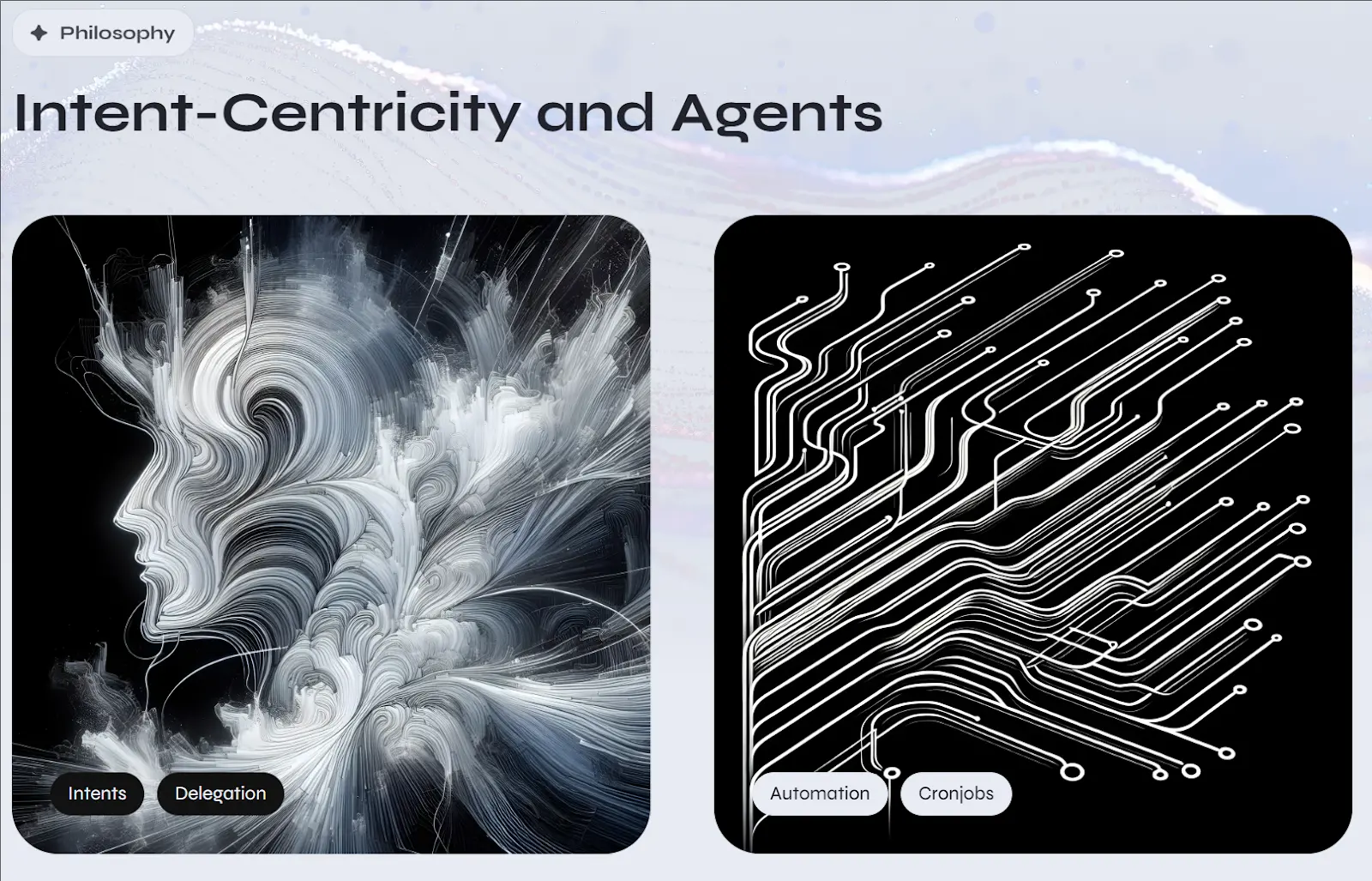
a. Core Value Proposition
- AI-Driven Simplified Experience
Supports natural language commands (e.g., "buy $200 SOL");
AI automatically identifies the optimal route and executes multi-step operations such as bridging and DEX trading.
- Autonomous Security and Dual Account Model
Vault Account: Fully managed by the user, with private keys held by the user;
Automated Account: Grants Kuvi AI permission to execute daily trading operations;
All assets are defaulted to the Vault and only transferred to the Automated account within the user's permission scope.
- User Experience Flow
Create Vault and Automated accounts after installation;
Users can set the AI's permission level (e.g., only execute low-risk trades, all trades require confirmation, etc.);
By inputting commands (e.g., "swap ETH for SOL"), users trigger Kuvi's AI to automatically handle cross-chain operations, find the optimal path, and execute trades.
b. Market Background and Opportunities
Existing Problems:
Complex cross-chain and DEX operations;
Complicated UI, prone to errors;
Lack of a unified entry point, leading to a fragmented experience.
Kuvi's Solutions:
"One message, complete the transaction";
Automatically select the optimal bridging/trading path;
Lower the entry barrier for beginners while providing efficient automated channels for professional users.
c. Platform Architecture and Technical Details
- Core Modules
AI NLP Engine: Understands user commands and plans the optimal trading path;
Trading Orchestration Layer: Implements cross-chain bridging, DEX aggregation, and path selection;
Atomic Transaction Packaging: Merges multi-step operations into a single smart contract call, ensuring success or rollback;
Security Permission Management:
AI can only access the Automated account;
Users can set limits, black/white lists, time locks, and other protective measures;
Vault assets can only be transferred out with user signatures.
- Cross-Chain and Integration Capabilities
Supports multiple bridging protocols (LayerZero, Hop, Connext, etc.);
Integrates multiple DEX aggregators (such as 1inch, Matcha);
Supports Solana, EVM chains (Arbitrum, Polygon), and plans to expand into non-EVM ecosystems in the future.
Tron Comments
Kuvi.ai addresses core pain points in the crypto world, such as fragmented user experience, cumbersome cross-chain processes, and weak security mechanisms, through its AI-driven interaction method of "Text-to-Trade." Its unique dual-account design ensures user sovereignty over funds while supporting an efficient daily trading experience. With a mature technical architecture, clear token mechanism, and defined market path, Kuvi has the potential to become a leader in the AI trading interface space.
2. Detailed Explanation of Key Projects of the Week
2.1. Detailed Analysis of Stable, a high-concurrency, low-latency, and highly scalable solution backed by leading exchanges Bitfinex, Kucoin, and BYBIT, which raised $28 million
Introduction
Stable provides a powerful, reliable, and cost-effective stablecoin blockchain solution optimized for USDT. By offering comprehensive features tailored for institutions, regular users, and developers, Stable enhances financial efficiency and drives exceptional operational performance.
Stable is designed to optimize USDT transactions, providing institutions with efficient, secure, and cost-effective payment and settlement solutions. Features aimed at enterprises include:
Dedicated blockchain space for enterprises (coming soon): Enterprises using blockchain infrastructure need to ensure consistent transaction latency. Stable offers exclusive allocation of blockchain space to enterprises, maintaining reliable transaction performance even during network congestion.
Built for USDT transactions: Stable enhances the issuance, settlement, and daily trading of USDT, capable of quickly and securely handling high-frequency large-scale USDT activities.
High transaction throughput: Stable supports rapid transaction processing, enabling institutions to quickly settle large transactions and achieve large-scale transfers through USDT transfer aggregation.
Security and reliability: Stable has robust security mechanisms that comprehensively protect transactions and assets. Its security architecture provides a trusted foundation for high-value settlements and critical financial operations.
Privacy transfers (coming soon): Stable offers enterprise-level confidential privacy transfer capabilities, allowing institutions to protect privacy while executing transactions and fully comply with regulatory requirements. Through advanced encryption technology, sensitive transaction data is not publicly displayed but can be audited by authorized parties. This allows enterprises to ensure necessary privacy while meeting regulations such as AML/KYC and financial audits, thereby building trust and operational confidence in a compliant financial environment.
Architecture Analysis
From state databases, execution engines, consensus mechanisms, to specific optimizations for USDT, Stable's design consistently focuses on performance, scalability, and reliability. Each layer of components in the tech stack is specifically optimized to support high-throughput workloads and seamless native USDT operations.
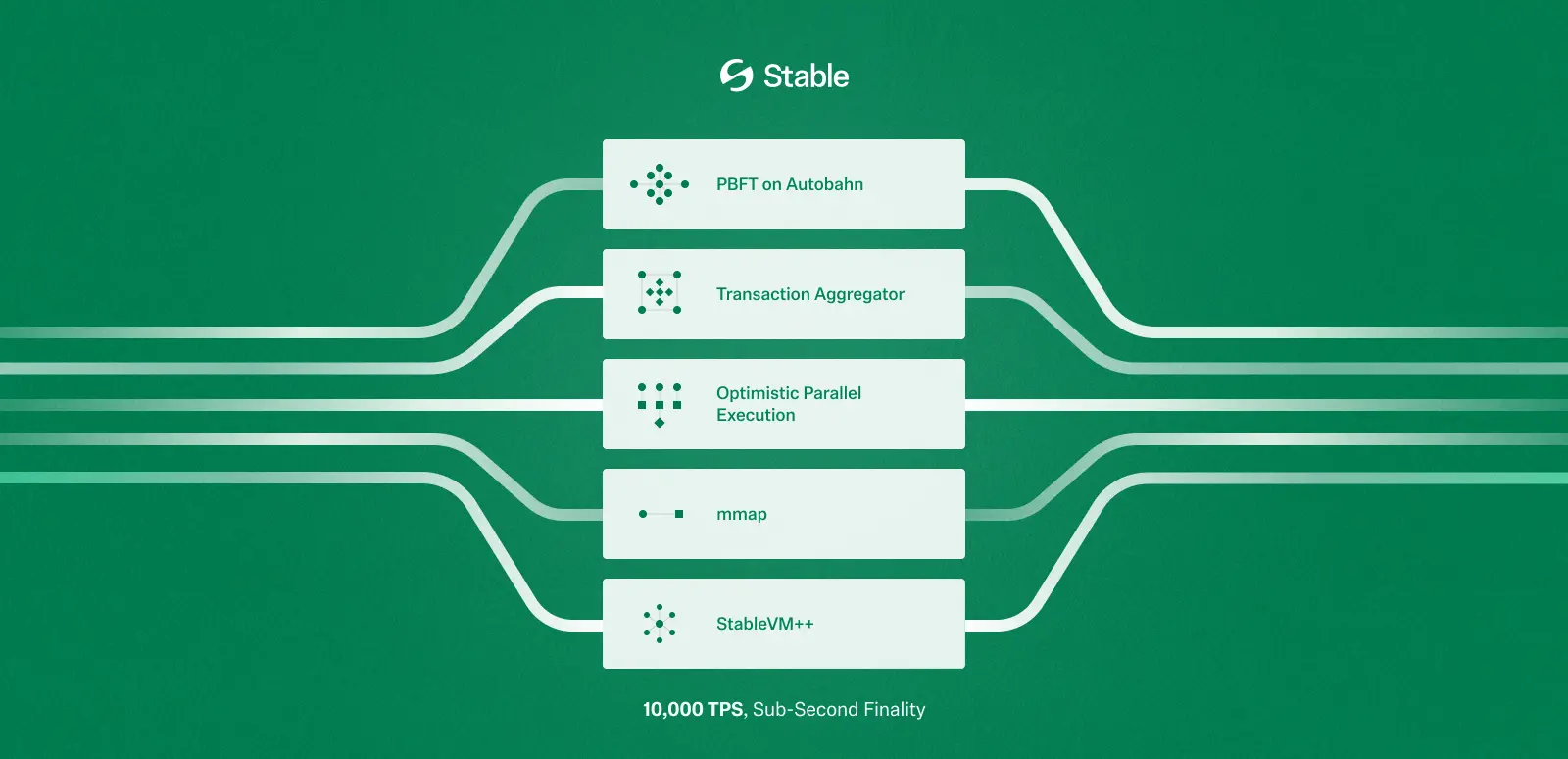
- Consensus
StableBFT Consensus Mechanism
In the initial phase, the Stable blockchain adopts StableBFT, a proof-of-stake (PoS) consensus protocol customized based on CometBFT, designed to ensure the network has high throughput, low latency, and high robustness. Its main advantages include high deterministic finality and strong fault tolerance (the network remains secure even if 1/3 of validators fail or act maliciously).
To further enhance consensus performance, Stable plans to optimize the two-layer mechanism related to consensus in the near future:
Separation of transaction propagation and consensus propagation: By separating the transaction gossip layer from the consensus gossip layer, it prevents network congestion in the transaction layer from affecting consensus communication, improving system stability.
Direct broadcasting of transactions to block proposers: In the current model, transactions are propagated between nodes through peer-to-peer gossip, resulting in a large amount of transaction-related traffic in the blockchain network. Stable plans to introduce a direct broadcasting mechanism to optimize this, allowing transactions to be sent directly to block proposers, thereby improving transaction propagation efficiency.
Future Plans: DAG-Based Consensus Mechanism
To significantly enhance consensus efficiency, Stable plans to upgrade its protocol to a DAG (Directed Acyclic Graph)-based design, expected to bring a 5-fold performance improvement.
Traditional view-based BFT protocols (such as PBFT and HotStuff) can achieve low latency under stable network conditions, but their performance drops sharply during network interruptions, with long recovery times.
First-generation DAG engines like Narwhal and Tusk demonstrate that decoupling data propagation from consensus ordering can eliminate the bottleneck of a single proposer and enhance robustness during network instability. However, such architectures are not directly compatible with the CometBFT system, as they deviate from traditional block height-based development habits and mempool design.
Autobahn provides a PBFT-on-DAG architecture that can better integrate with Stable's consensus layer, achieving low latency under normal network conditions and rapid recovery during network failures. The Stable team maintains close collaboration with the authors of the Autobahn paper and will leverage the Autobahn architecture to enhance the performance of StableBFT.
The StableBFT built on the Autobahn architecture will bring the following capabilities:
Eliminate the single leader limitation, enabling parallel processing.
Decouple data propagation from final ordering, achieving faster finality.
Enhance the system's processing resilience under abnormal network conditions through a robust BFT mechanism.
This advanced consensus design has been validated through internal prototypes, achieving high throughput performance of over 200,000 TPS (only consensus layer) in a controlled environment.
- Execution Layer
Stable EVM
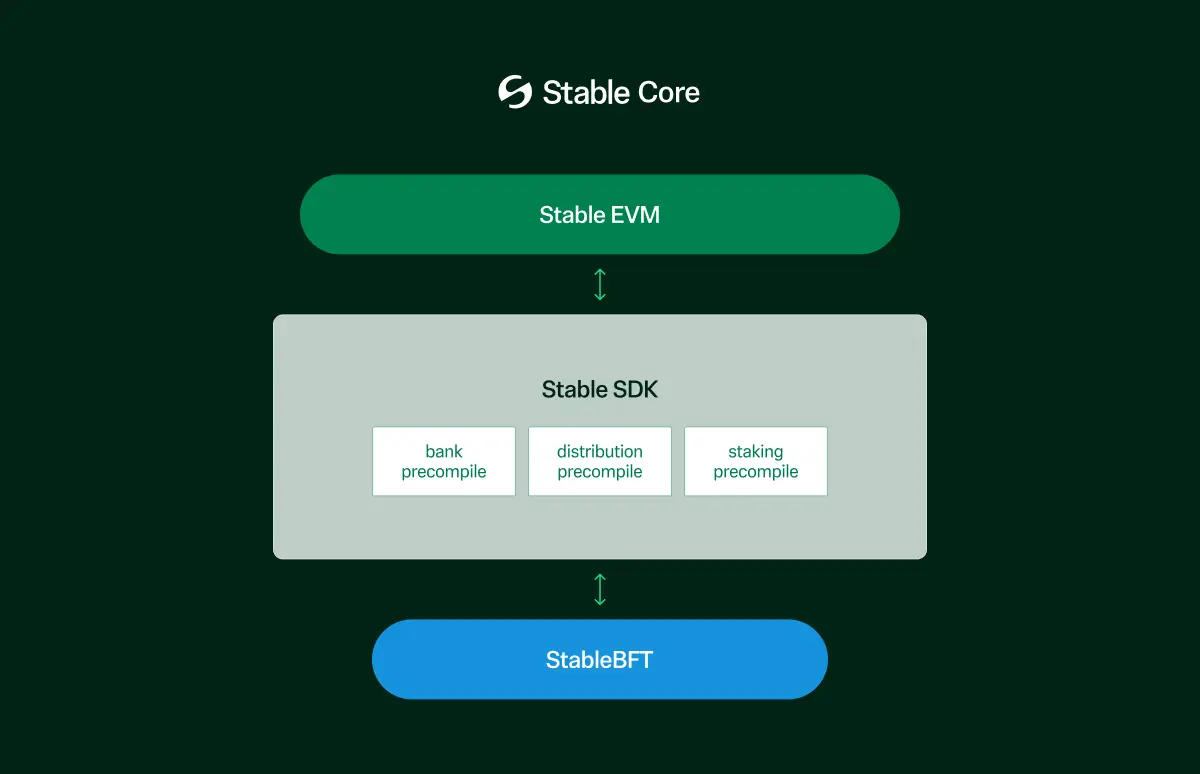
- Introduction to Stable EVM
Stable EVM is the Ethereum-compatible execution layer of the Stable blockchain, allowing users to interact seamlessly through commonly used Ethereum tools (such as MetaMask).
It combines the familiar development experience of EVM with the modular high-performance infrastructure of Stable SDK.
It introduces precompiled contracts, allowing EVM contracts to safely and atomically call underlying functions such as token transfers, staking, governance, and more.
- Overview of Optimistic Parallel Execution (OPE)
Traditional chains use sequential execution mechanisms, which maintain consistency but limit throughput and scalability.
OPE proposes to solve the above bottlenecks: achieving parallel processing of multiple transactions while maintaining consistency.
Stable adopts OPE as a core performance enhancement strategy, introducing the Block-STM parallel execution engine.
- Core Principles of Block-STM
① Multi-Version Memory Structure (MVCC)
Each memory key supports multiple versions, with transactions reading the last committed version.
All read and write operations are tagged with version markers for subsequent conflict validation.
② Read-Set / Write-Set Validation Mechanism
The execution phase records the read (Read-Set) and write (Write-Set) contents of transactions.
If a key in the Read-Set is found to be written by another transaction during the validation phase, it is considered a conflict, requiring rollback and retry.
③ ESTIMATE Marking Mechanism
The Write-Set of failed transactions is marked as ESTIMATE.
Other transactions reading this mark will immediately trigger a wait, avoiding invalid execution.
④ Preset Transaction Order
All transactions are preset in a fixed order, maintaining consistency whether executed in parallel or validated.
Ensures that even with retries, all node states remain consistent.
⑤ Collaborative Scheduler
Safely allocates tasks for execution/validation phases in a thread-safe manner.
Prioritizes scheduling transactions with smaller indices (earlier), reducing retry rates and improving throughput.
- Advantages of Block-STM
Lock-free parallelism: Based on MVCC, no locking is required, improving concurrency efficiency for multiple transactions.
Rapid conflict detection: By using ESTIMATE to preemptively abort dependent transactions, resources are saved.
Efficient scheduling: Prioritizes early transactions, reducing latency.
Strong determinism: Even with rollback retries, all nodes ultimately reach a consistent state.
- Synergy of OPE and OBP on Stable
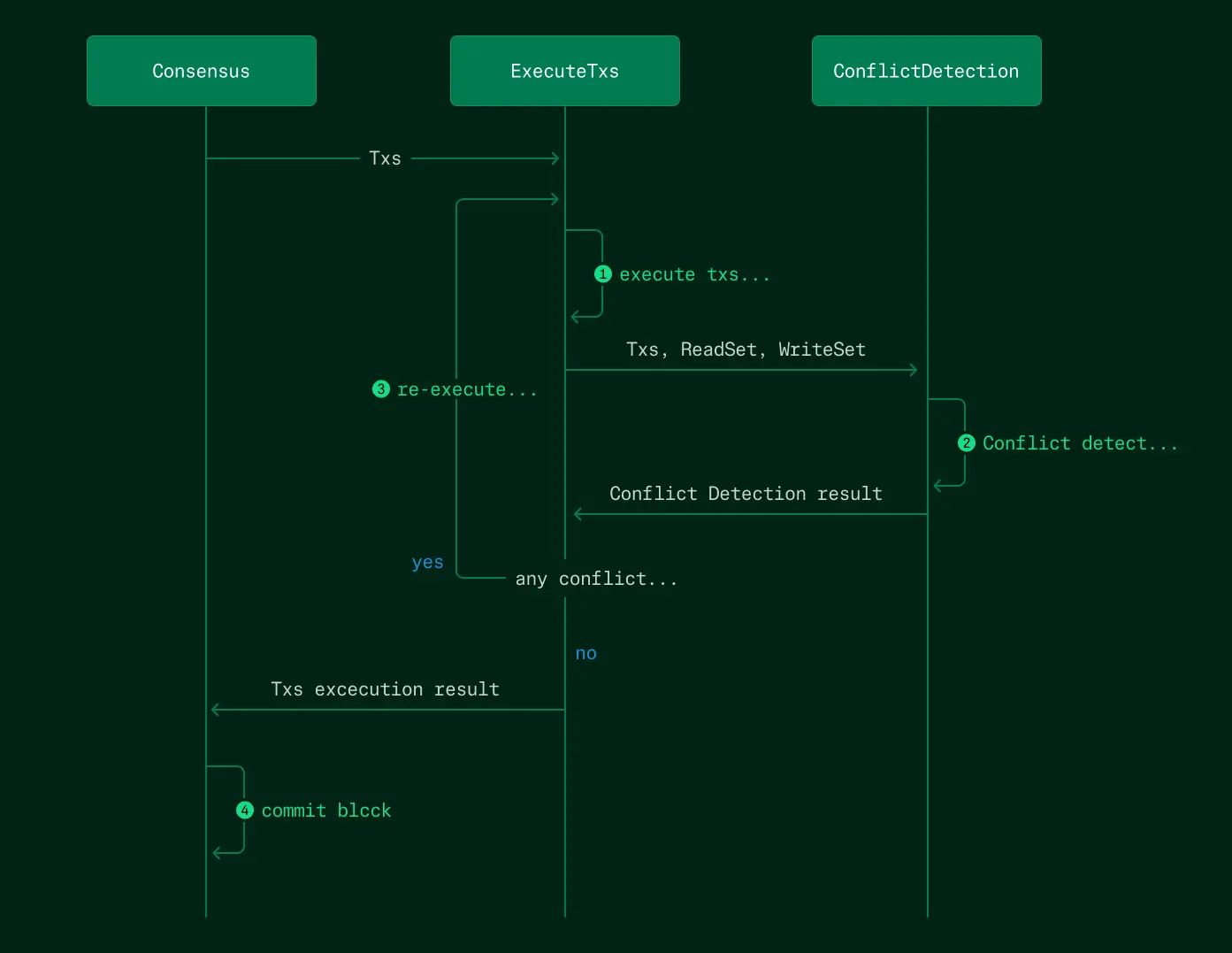
OPE (Optimistic Parallel Execution)
- Parallel execution of transactions to enhance throughput and execution efficiency.
OBP (Optimistic Block Processing)
Non-parallel, but executes blocks in advance:
During the ProcessProposal phase, executes while gossiping.
Caches execution results for reuse in the FinalizeBlock phase, avoiding redundant calculations.
The two complement each other:
OPE addresses concurrency performance bottlenecks, while OBP optimizes execution timing;
Together, they achieve higher transaction processing capacity and lower latency.
- Performance Expectations
Internal testing indicates:
Combining Block-STM (OPE) with StableDB,
The transaction processing throughput of Stable can be improved by at least 2 times.
- StableDB
Two major architectural optimizations of Stable
- Decoupling state submission from state storage
State submission occurs immediately after execution;
Disk persistence of state data is handled by an asynchronous background process;
Benefits:
Avoids blocking the execution of the next block due to disk writes;
Significantly enhances transaction processing speed and overall system throughput.
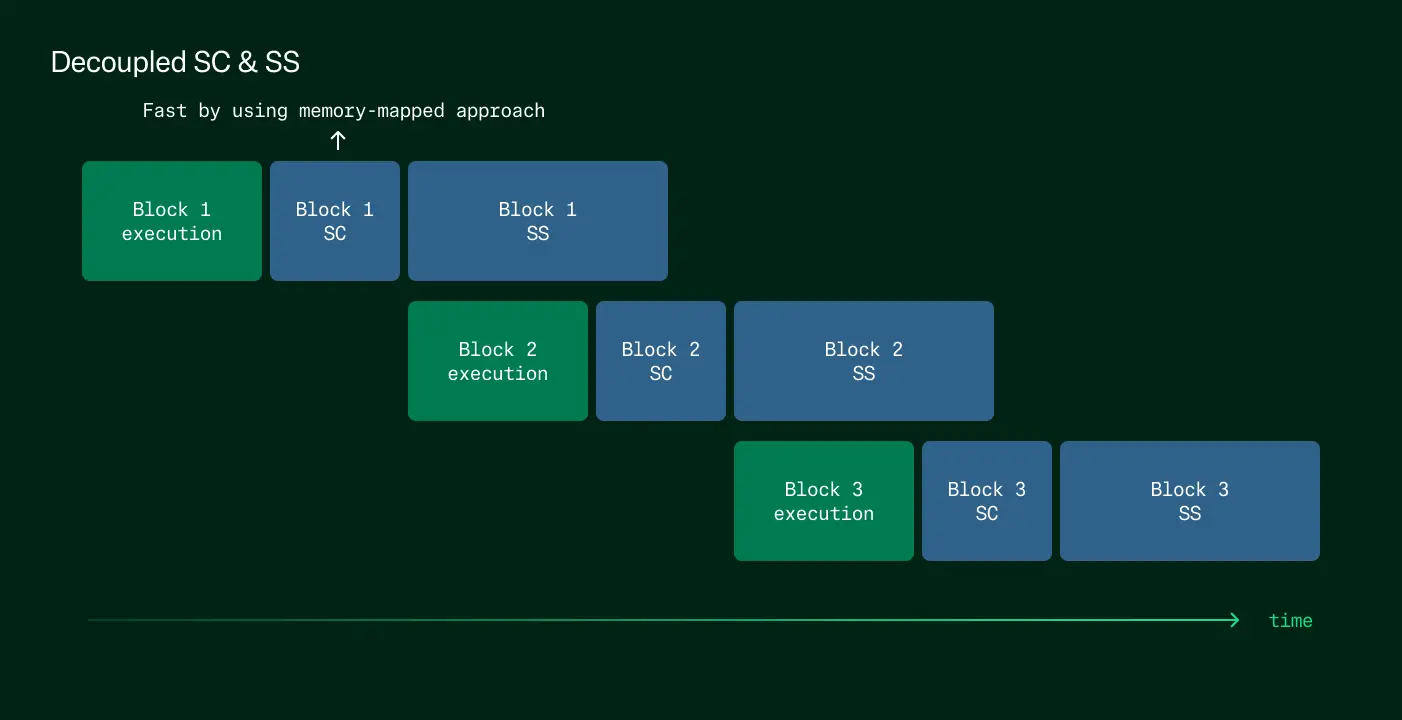
- Introduction of a mmap-based dual database system
Efficient state storage structure achieved through memory-mapped files (mmap):
MemDB (Active State Database):
Resides in memory, mapped to a fixed address;
Stores current hot states, supporting high-speed lookups;
Suitable for frequent read/write and real-time transaction processing.
VersionDB (Historical State Database):
Persistently stores earlier states;
Designed for archiving and audit queries, with low access frequency;
Used for historical backtracking and verification, non-critical path operations.
- High-Performance RPC
In building a high-performance blockchain, merely optimizing the consensus mechanism or block production speed is insufficient. The RPC layer serves as the interface between the blockchain and users, a key component for achieving end-to-end user experience. Stable proposes a high-performance RPC architecture aimed at breaking through the performance bottlenecks of traditional RPC.
a. Summary of Stable's Split-Path RPC Architecture
Core Concept of the Architecture: Path Separation (Split-Path)
Stable's RPC system adopts the concept of path separation, completely splitting and optimizing read and write operations to avoid performance interference.
Functional split nodes:
Each function is deployed on different lightweight nodes (e.g., read-only / write-only), allowing each type of RPC request to have an independent processing path;Edge node expansion mechanism:
Deploys lightweight, stateless RPC edge nodes in multiple regions, providing low-latency access points close to users;Function-based path optimization:
Optimizes underlying data access paths and data structures based on the characteristics of read/write requests, improving response efficiency.
b. Read Path Performance Metrics
Internal testing of Stable shows strong performance in its read path:
Performance Metrics
Results
Throughput Capacity
Single node supports over 10,000 RPS
Request Latency
End-to-end latency below 100ms
Scalability
Edge nodes support linear expansion without needing to synchronize state or participate in consensus
Tron Comments
Stable effectively addresses the bottlenecks in throughput, I/O, and query performance of traditional blockchains by introducing Stable EVM, Block-STM parallel execution engine, StableDB storage optimization, and Split-Path RPC architecture. Its unique decoupling of state submission/storage, memory-mapped databases, and multi-path RPC architecture provide:
Extremely high execution concurrency and compatibility with determinism;
Extremely low disk latency and state read/write overhead;
Support for rapid expansion of lightweight edge nodes;
Optimization of on-chain/off-chain resource coordination, enhancing terminal response experience.
However, the highly modular design of Stable also presents some challenges, such as:
High system complexity, requiring fine-tuning of mechanisms like schedulers and conflict retries;
mmap and memory databases still face memory pressure under large state volumes;
Asynchronous state persistence may increase data consistency management costs under extreme conditions;
For developers, precompiled contracts and path separation architecture require additional adaptation.
III. Industry Data Analysis
- Overall Market Performance
1.1. Spot BTC vs ETH Price Trends
BTC
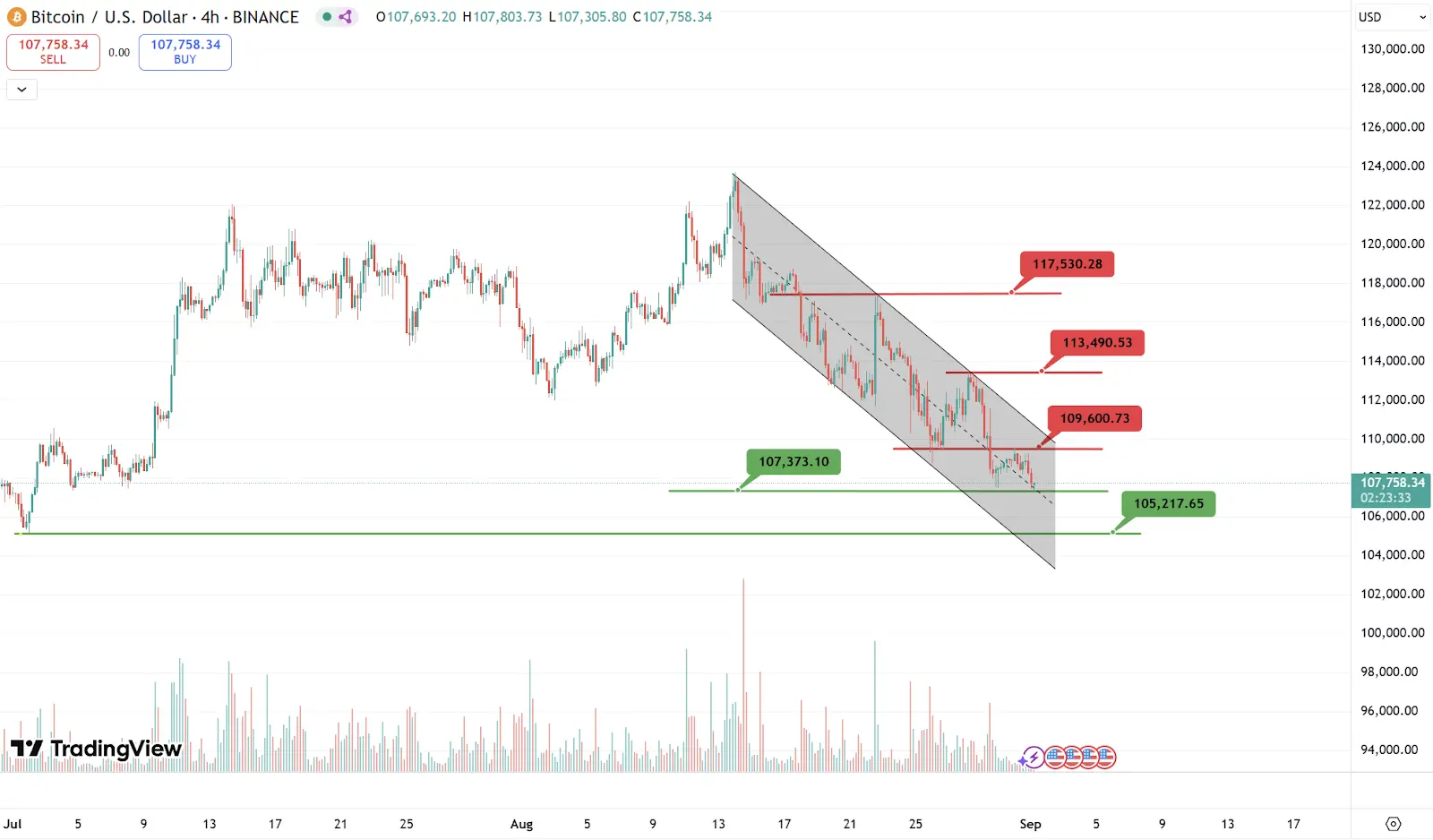
Analysis
Key resistance this week: $109,600, $113,500, $117,500
Key support this week: $107,300, $105,200
ETH
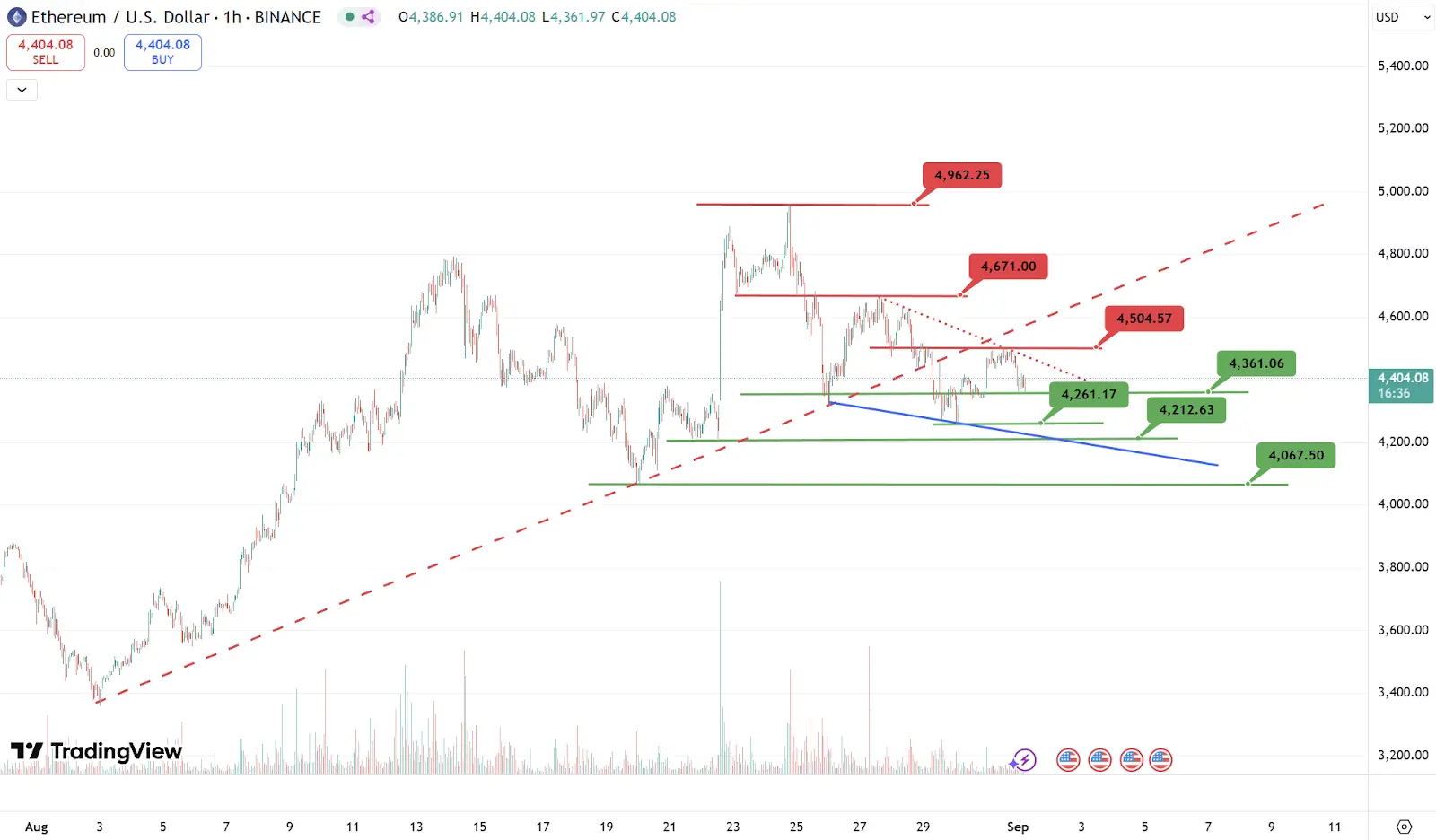
Analysis
Key resistance this week: $4,500, $4,670, $4,960
Key support this week: $4,360, $4,260, $4,210, $4,070
- Public Chain Data
2.1. BTC Layer 2 Summary
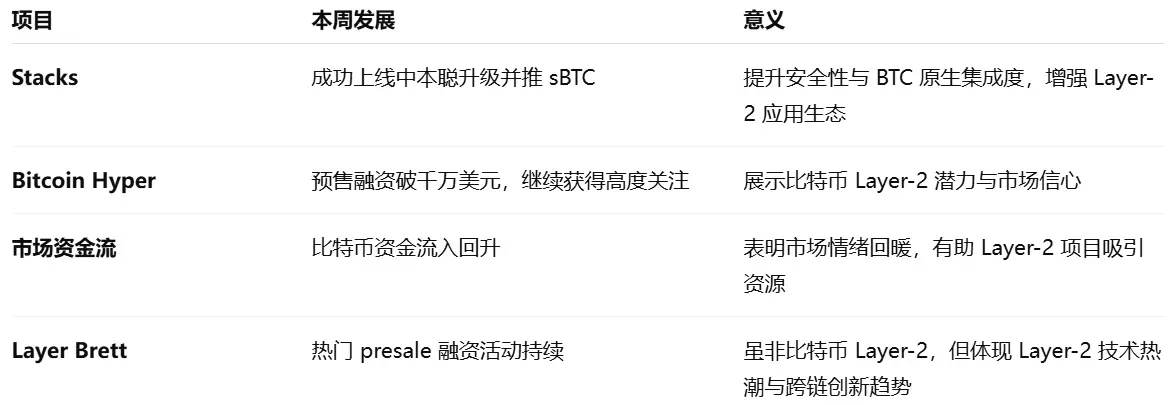
2.2. EVM & Non-EVM Layer 1 Summary
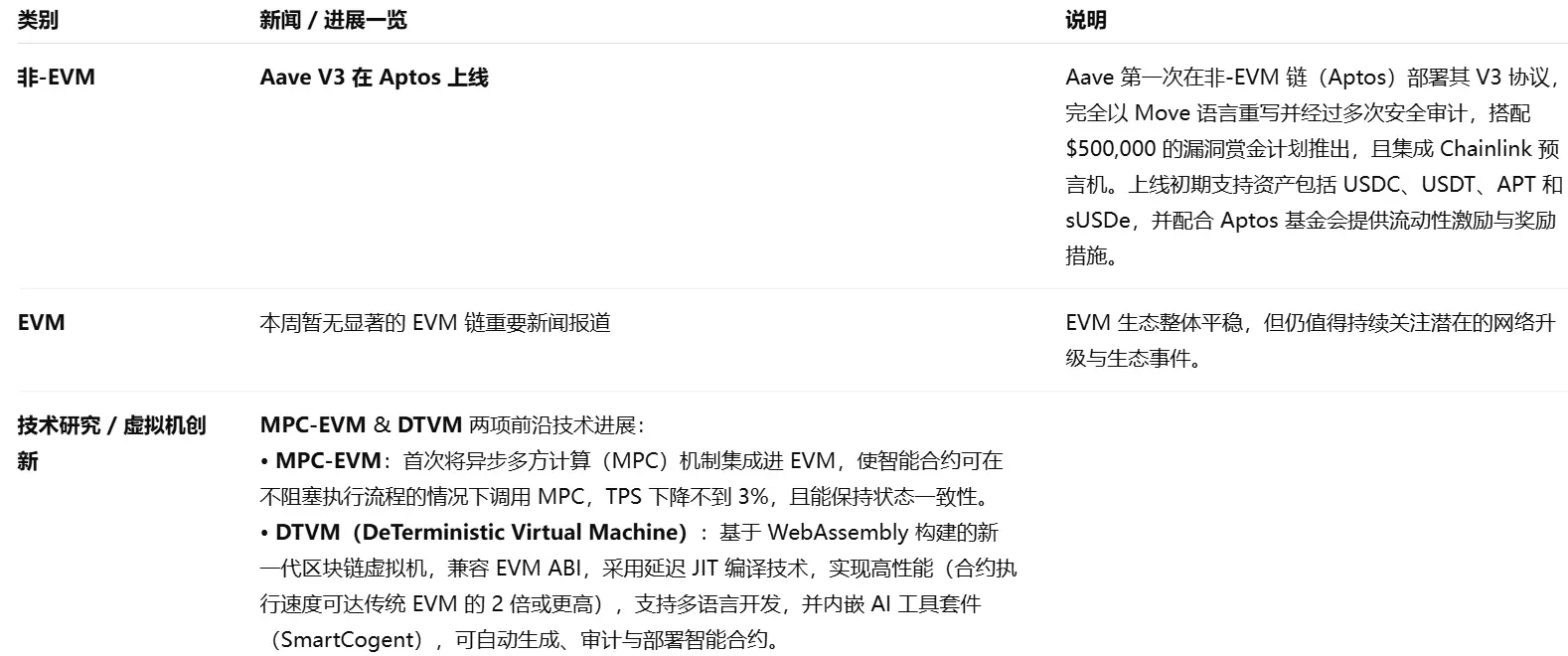
2.3. EVM Layer 2 Summary
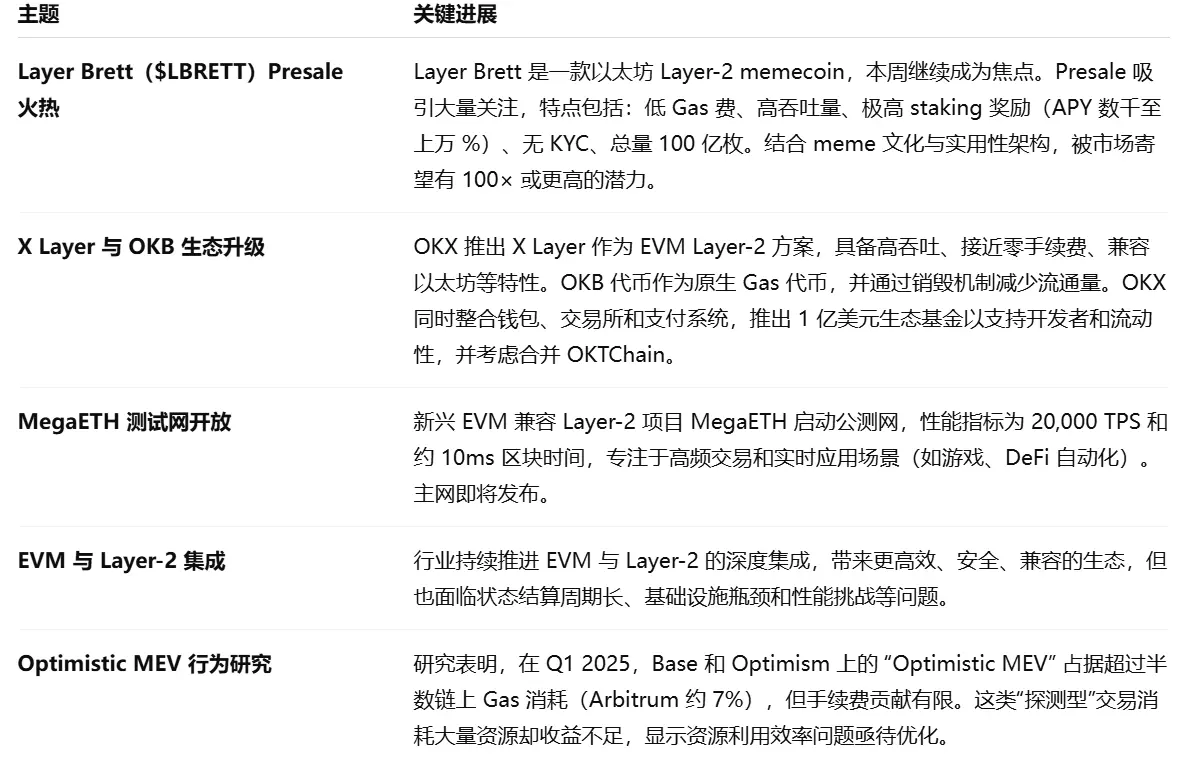
IV. Macroeconomic Data Review and Key Data Release Nodes for Next Week
The annualized GDP growth rate for the United States in the second quarter was revised up to 3.3%, better than previously expected, rebounding significantly from -0.5% in the first quarter. The main drivers include strong consumer spending and growth in AI infrastructure investment, with net exports also contributing significantly. Corporate profits rose by 1.7% year-on-year, and Gross Domestic Income (GDI) surged to 4.8%.
Important macroeconomic data nodes for this week (September 1 - September 5) include:
September 2: US August ISM Manufacturing PMI
September 4: US August ADP Employment Numbers
September 5: US August Unemployment Rate; US August Seasonally Adjusted Non-Farm Payrolls
V. Regulatory Policies
United States
SEC appoints new enforcement head, regulatory style shifts to institutional
The U.S. Securities and Exchange Commission has appointed a new head of enforcement, strengthening structured regulation. Additionally, the Commodity Futures Trading Commission (CFTC) and the Treasury Department are seeking public input to expand the regulatory framework for digital assets.Trump family launches a crypto empire valued at approximately $6.42 billion
Trump Media Group partners with Crypto.com and Yorkville Acquisition to launch a new digital asset treasury primarily based on the CRO token, including approximately $1 billion in CRO tokens, $200 million in cash, and $5 billion in equity. They are also promoting the Truth Social platform to adopt a CRO rewards system and planning stablecoins and Bitcoin ETFs.Tether hires former White House crypto advisor to assist with policy
A former White House digital asset advisor joins the stablecoin leader Tether to expand its U.S. operations while leveraging legislative experience to navigate the crypto policy landscape.Dollar stablecoins and digital assets gradually integrate into American society
Payment platform Stripe supports stablecoins to maintain the global status of the dollar; the U.S. is also incorporating crypto assets into retirement plans. Meanwhile, the European Central Bank is promoting the construction of a digital euro to counter the influence of stablecoins.U.S. government establishes strategic Bitcoin reserves
A Trump executive order establishes a "strategic Bitcoin reserve," incorporating government-seized Bitcoin, Ethereum, Solana, etc., as national reserves. The U.S. government is currently estimated to hold about 198,000 Bitcoins.
Europe and the UK
Delays in UK stablecoin regulation raise concerns in the fintech sector
UK regulators are slow to act, prompting fintech companies (such as Coinbase, Noah) to urge the government to establish a national stablecoin policy, or risk losing their innovative edge. The Bank of England is concerned that stablecoins may replace traditional bank currencies.EU MiCA fully effective, establishing a unified regulatory framework
Since the end of 2024, the EU Market Crypto Assets Regulation (MiCA) has been fully implemented, promoting the integration of the digital asset regulatory ecosystem within the region and enhancing investor protection and market transparency.
Asia
Hong Kong advances stablecoin regulations
Hong Kong's "Stablecoin Ordinance" is expected to pass in May 2025, with the first batch of stable licenses anticipated to be issued as early as early 2026, requiring issuers to meet anti-money laundering, risk management, and corporate governance standards.Bahrain allows stablecoin issuance
The Central Bank of Bahrain will launch the SIO module in July 2025, allowing stablecoins to be issued based on local currency or U.S. dollars after approval.Pakistan establishes a crypto regulatory body
Pakistan has formed a "Crypto Committee" and invited a co-founder of Binance to serve as an advisor, initiating a Bitcoin reserve pilot and allocating power resources to develop mining and AI data centers.Regional regulation tightening, but innovation soil remains
Some regions in Asia continue to promote KYC/AML mechanisms, with clear regulations, expected to become a new engine for the next wave of crypto innovation.
免责声明:本文章仅代表作者个人观点,不代表本平台的立场和观点。本文章仅供信息分享,不构成对任何人的任何投资建议。用户与作者之间的任何争议,与本平台无关。如网页中刊载的文章或图片涉及侵权,请提供相关的权利证明和身份证明发送邮件到support@aicoin.com,本平台相关工作人员将会进行核查。




